Summary of Wassily Kandinsky
One of the pioneers of abstract modern art, Wassily Kandinsky exploited the evocative interrelation between color and form to create an aesthetic experience that engaged the sight, sound, and emotions of the public. He believed that total abstraction offered the possibility for profound, transcendental expression and that copying from nature only interfered with this process. Highly inspired to create art that communicated a universal sense of spirituality, he innovated a pictorial language that only loosely related to the outside world, but expressed volumes about the artist's inner experience. His visual vocabulary developed through three phases, shifting from his early, representational canvases and their divine symbolism to his rapturous and operatic compositions, to his late, geometric and biomorphic flat planes of color. Kandinsky's art and ideas inspired many generations of artists, from his students at the Bauhaus to the Abstract Expressionists after World War II.
Accomplishments
- Painting was, above all, deeply spiritual for Kandinsky. He sought to convey profound spirituality and the depth of human emotion through a universal visual language of abstract forms and colors that transcended cultural and physical boundaries.
- Kandinsky viewed non-objective, abstract art as the ideal visual mode to express the "inner necessity" of the artist and to convey universal human emotions and ideas. He viewed himself as a prophet whose mission was to share this ideal with the world for the betterment of society.
- Kandinsky viewed music as the most transcendent form of non-objective art - musicians could evoke images in listeners' minds merely with sounds. He strove to produce similarly object-free, spiritually rich paintings that alluded to sounds and emotions through a unity of sensation.
The Life of Wassily Kandinsky
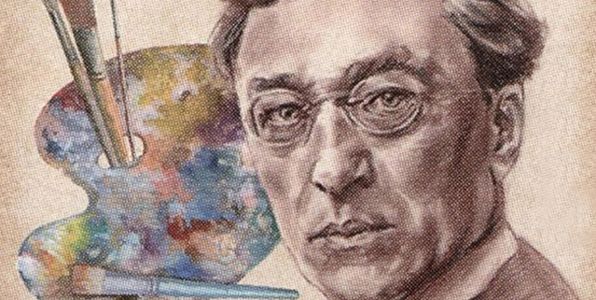
Modernist abstraction could not have asked for a more charismatic and visionary theorist than Kandinsky - the highest ideals he pursued through his many travels and friendships.
Important Art by Wassily Kandinsky
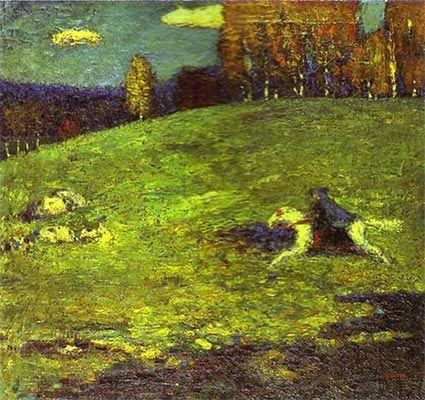
Der Blaue Reiter (The Blue Rider)
This breakthrough work is a deceptively simple image - a lone rider racing across a landscape - yet it represented a decisive moment in Kandinsky's developing style. In this painting, he demonstrated a clear stylistic link to the work of the Impressionists, like Claude Monet, particularly evident in the contrasts of light and dark on the sun-dappled hillside. The ambiguity of the form of the figure on horseback rendered in a variety of colors that almost blend together foreshadow his interest in abstraction. The theme of the horse and rider reappeared in many of his later works. For Kandinsky this motif signified his resistance against conventional aesthetic values as well as the possibilities for a purer, more spiritual life through art.
Oil on canvas - Private Collection
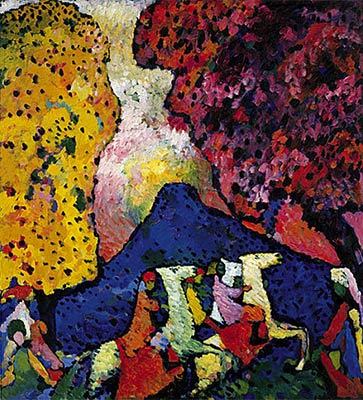
Der Blaue Berg (The Blue Mountain)
In this work, the influence of the Fauves on Kandinsky's color palette is apparent as he distorted colors and moved away from the natural world. He presented a bright blue mountain, framed by a red and yellow tree on either side. In the foreground, riders on horseback charge through the scene. At this stage in Kandinsky's career, Saint John's Book of Revelation became a major literary source for his art, and the riders signify the four horsemen of the apocalypse. The horsemen, although an indicator of the mass destruction of the apocalypse, also represent the potential for redemption afterward.
Kandinsky's vibrant palette and expressive brushwork provide the viewer with a sense of hope rather than despair. Further, the brilliant colors and dark outlines recall his love of the Russian folk art. These influences would remain part of Kandinsky's style throughout the rest of his career, with bright colors dominating his representational and non-objective canvases. From this figurative and highly symbolic work, Kandinsky progressed further towards pure abstraction. The forms are already schematized from their observable appearance in the surrounding world in this canvas, and his abstraction only progressed as Kandinsky refined his theories about art.
Oil on canvas - The Solomon R. Guggenheim Museum, New York
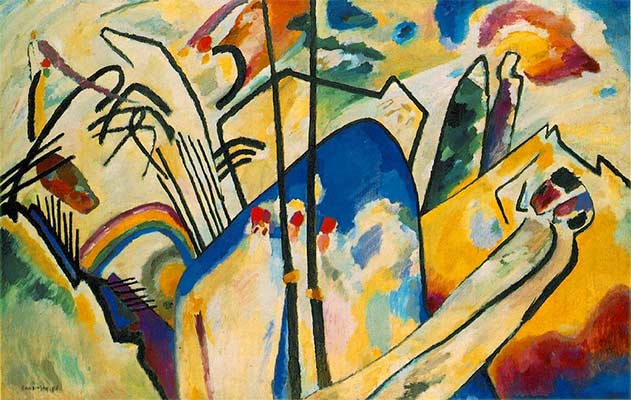
Composition IV
Hidden within the bright swaths of color and the clear black lines of Composition IV, Kandinsky portrayed several Cossacks with lances, as well as boats, reclining figures, and a castle on a hilltop. As with many paintings from this period, he represented the apocalyptic battle that would lead to eternal peace. The notion of battle is conveyed by the Cossacks, while the calm of the flowing forms and reclining figures on the right alludes to the peace and redemption to follow. In order to facilitate his development of a non-objective style of painting, as described in his text Concerning the Spiritual in Art (1912), Kandinsky reduced objects to pictographic symbols. Through his elimination of most references to the outside world, Kandinsky expressed his vision in a more universal manner, distilling the spiritual essence of the subject through these forms into a visual vocabulary. Many of these symbolic figures were repeated and refined in later works, becoming further and further abstracted as Kandinsky developed his mature, purely abstract style.
Oil on canvas - Kunstsammlung Nordrhein-Westfallen, Düsseldorf
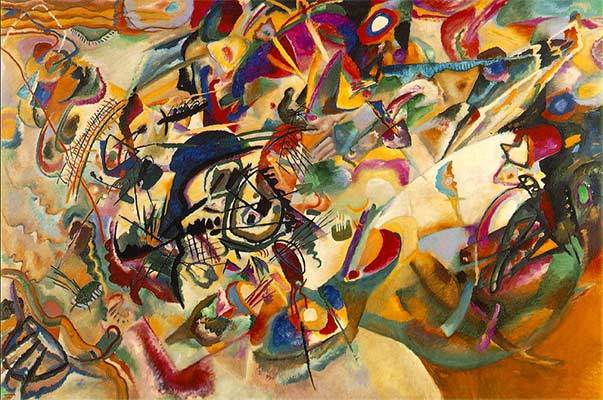
Composition VII
Commonly cited as the pinnacle of Kandinsky's pre-World War I achievement, Composition VII shows the artist's rejection of pictorial representation through a swirling hurricane of colors and shapes. The operatic and tumultuous roiling of forms around the canvas exemplifies Kandinsky's belief that painting could evoke sounds the way music called to mind certain colors and forms. Even the title, Composition VII, aligned with his interest in the intertwining of the musical with the visual and emphasized Kandinsky's non-representational focus in this work. As the different colors and symbols spiral around each other, Kandinsky eliminated traditional references to depth and laid bare the different abstracted glyphs in order to communicate deeper themes and emotions common to all cultures and viewers.
Preoccupied by the theme of apocalypse and redemption throughout the 1910s, Kandinsky formally tied the whirling composition of the painting to the theme of the cyclical processes of destruction and salvation. Despite the seemingly non-objective nature of the work, Kandinsky maintained several symbolic references in this painting. Among the various forms that built Kandinsky's visual vocabulary, he painted glyphs of boats with oars, mountains, and figures. However, he did not intend for viewers to read these symbols literally and instead imbued his paintings with multiple references to the Last Judgment, the Deluge, and the Garden of Eden, seemingly all at once.
Oil on canvas - Tretyakov Gallery, Moscow
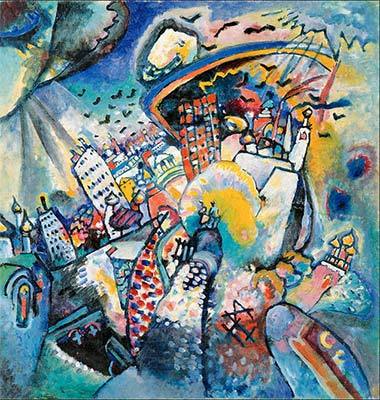
Moscow I (Red Square)
At first the move to Moscow in 1914 initiated a period of depression and Kandinsky hardly even painted at all his first year back. When he picked up his paintbrush again in 1916, he expressed his desire to paint a portrait of Moscow in a letter to his former companion, Munter. Although he continued to refine his abstraction, he represented the city's monuments in this painting and captured the spirit of the city. Kandinsky painted the landmarks in a circular fashion as if he had stood in the center of Red Square, turned in a circle, and caught them all swirling about him. Although he refers to the outside world in this painting, he maintained his commitment to the synesthesia of color, sound, and spiritual expression in art. Kandinsky wrote that he particularly loved sunset in Moscow because it was "the final chord of a symphony which develop[ed] in every tone a high life that force[d] all of Moscow to resound like the fortissimo of a huge orchestra."
Oil on canvas - The State Tretyakov Gallery, Moscow
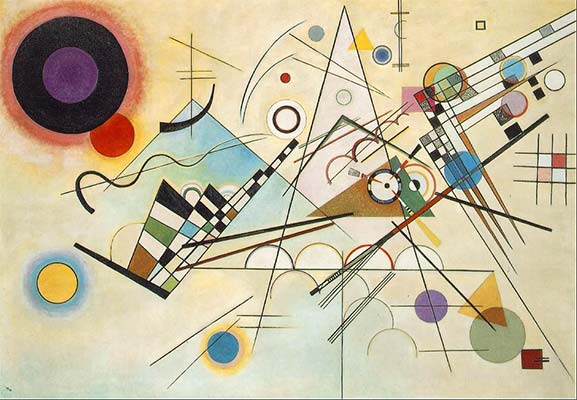
Composition VIII
The rational, geometric order of Composition VIII is a polar opposite of the operatic composition of Composition VII (1913). Painted while he taught at the Bauhaus, this work illustrates how Kandinsky synthesized elements from Suprematism, Constructivism, and the school's own ethos. By combining aspects of all three movements, he arrived at the flat planes of color and the clear, linear quality seen in this work. Form, as opposed to color, structured the painting in a dynamic balance that pulses throughout the canvas. This work is an expression of Kandinsky's clarified ideas about modern, non-objective art, particularly the significance of shapes like triangles, circles, and the checkerboard. Kandinsky relied upon a hard-edged style to communicate the deeper content of his work for the rest of his career.
Oil on canvas - The Solomon R. Guggenheim Museum, New York
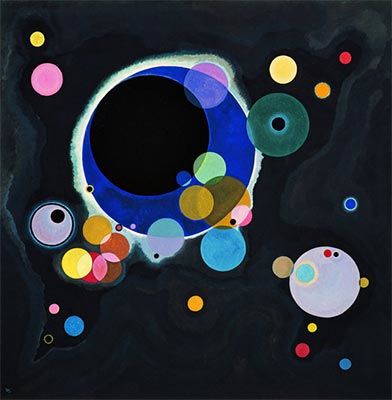
Several Circles
Kandinsky painted this work in his sixtieth year and it demonstrates his lifelong search for the ideal form of spiritual expression in art. Created as part of his experimentation with a linear style of painting, this work shows his interest in the form of the circle. "The circle," claimed Kandinsky, "is the synthesis of the greatest oppositions. It combines the concentric and the eccentric in a single form and in equilibrium. Of the three primary forms, it points most clearly to the fourth dimension." He relied upon the varied possibilities of interpretation for the circle to create a sense of spiritual and emotional harmony in this work. The diverse dimensions and bright hues of each circle bubble up through the canvas and are balanced through Kandinsky's careful juxtapositions of proportion and color. The dynamic movement of the round forms evokes their universality - from the stars in the cosmos to drops of dew; the circle a shape integral to life.
Oil on canvas - The Solomon R. Guggenheim Museum, New York
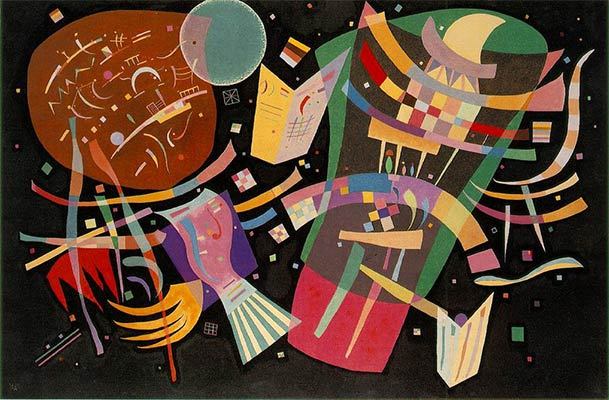
Composition X
Influenced by the flowing biomorphic forms of Surrealism, Kandinsky later incorporated organic shapes back into his pictorial vocabulary. Executed in France, this monumental painting relies upon a black background to heighten the visual impact of the brightly colored undulating forms in the foreground. The presence of the black expanse is significant, as Kandinsky only used the color sparingly; it is evocative of the cosmos as well as the darkness at the end of life. The undulating planes of color call to mind microscopic organisms, but also express the inner emotional and spiritual feelings Kandinsky experienced near the end of his life. The uplifting organization of forms in contrast with the harsh edges and black background illustrates the harmony and tension present throughout the universe, as well as the rise and fall of the cycle of life. Last in his lifelong series of Compositions, this work is the culmination of Kandinsky's investigation into the purity of form and expression through nonrepresentational painting.
Oil on canvas - Kunstsammlung Nordrhein-Westfalen, Düsseldorf
Biography of Wassily Kandinsky
Childhood
Wassily (Vasily) Wassilyevich Kandinsky was born in 1866 in Moscow to well educated, upper-class parents of mixed ethnic origins. His father was born close to Mongolia, while his mother was a Muscovite, and his grandmother was from the German-speaking Baltic. The bulk of Kandinsky's childhood was spent in Odesa, a thriving, cosmopolitan city populated by Western Europeans, Mediterraneans, and a variety of other ethnic groups. At an early age, Kandinsky exhibited an extraordinary sensitivity toward the stimuli of sounds, words, and colors. His father encouraged his unique and precocious gift for the arts and enrolled him in private drawing classes, as well as piano and cello lessons. Despite early exposure to the arts, Kandinsky did not turn to painting until he reached the age of 30. Instead, he entered the University of Moscow in 1886 to study law, ethnography, and economics. In spite of the legal focus of his academic pursuits, Kandinsky's interest in color symbolism and its effect on the human psyche grew throughout his time in Moscow. In particular, an ethnographic research trip in 1889 to the region of Vologda, in northwest Russia, sparked an interest in folk art that Kandinsky carried with him throughout his career. After completing his degree in 1892, he started his career in law education by lecturing at the university.
Early Training
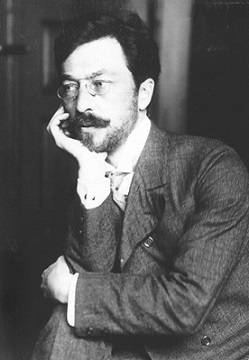
Despite his success as an educator, Kandinsky abandoned his career teaching law to attend art school in Munich in 1896. For his first two years in Munich he studied at the art school of Anton Azbe, and in 1900 he studied under Franz von Stuck at the Academy of Fine Arts. At Azbe's school he met co-conspirators such as Alexei Jawlensky, who introduced Kandinsky to the artistic avant-garde in Munich. In 1901, along with three other young artists, Kandinsky co-founded "Phalanx" - an artist's association opposed to the conservative views of the traditional art institutions. Phalanx expanded to include an art school, in which Kandinsky taught, and an exhibitions group. In one of his classes at the Phalanx School, he met and began a relationship with his student, Gabriele Munter, who became his companion for the next 15 years. As he traveled throughout Europe and northern Africa with Munter from 1903 until 1909, Kandinsky familiarized himself with the growing Expressionist movement and developed his own style based on the diverse artistic sources he witnessed on his travels.

Kandinsky painted his breakthrough work, Der Blaue Reiter (1903) during this transitional period. This early work revealed his interest in disjointed figure-ground relationships and the use of color to express emotions rather than appearances - two aspects that would dominate his mature style. In 1909, he was one of the founding members of Neue Kunstlervereinigung Munchen (NKVM, or New Artists Association of Munich), a group that sought to accommodate the avant-garde artists whose practices were too radical for the traditional organizations and academies of the time. His paintings became more and more abstracted from the surrounding world as he gradually refined his style. He began titling works Improvisation, Composition, or Impression to further stress their distance from the objective world and continued to use similar titles throughout the rest of his career.
Mature Period
In 1911, in response to the rejection of one of Kandinsky's paintings from the annual NKVM exhibition, he and Franz Marc organized a rival exhibition and co-founded "Der Blaue Reiter" (The Blue Rider) - a loose association of nine Expressionist artists that included August Macke, Munter, and Jawlensky. Though their aims and approaches varied from artist to artist, in general the group believed in the promotion of modern art and the possibility for spiritual experience through the symbolic associations of sound and color - two issues very near and dear to Kandinsky's heart. Despite the similarities between the group's moniker and the title of Kandinsky's 1903 painting, the artists actually arrived at the name "Der Blaue Reiter" as a result of the combination of Marc's love of horses and Kandinsky's interest in the symbolism of the rider, coupled with both artists' penchant for the color blue. During their short tenure, the group published an anthology (The Blue Rider Almanac) and held three exhibitions. Additionally, Kandinsky published Concerning the Spiritual in Art (1911), his first theoretical treatise on abstraction that articulated his theory that the artist was a spiritual being that communicated through and was affected by line, color, and composition. He produced both abstract and figurative works at this time, but expanded his interest in non-objective painting. Composition VII (1913) was an early example of his synthesis of spiritual, emotional, and non-referential form through complex patterns and brilliant colors. The outbreak of World War I in 1914 led to the dissolution of Der Blaue Reiter, but, despite their short tenure, the group initiated and deeply inspired the highly influential German Expressionist style.
After Germany declared war on Russia, Kandinsky was forced to leave the country. He traveled to Switzerland and Sweden with Munter for almost two years, but returned to Moscow in early 1916, which effectively ended their relationship. In Moscow he courted and married Nina Andreevskaia, the young daughter of a Czarist colonel. While there, he not only became familiar with the art of Constructivists and Suprematists like Vladimir Tatlin and Kazimir Malevich, but also lived in the same building as Aleksander Rodchenko, and met other avant-garde luminaries like Naum Gabo, Lyubov Popova, and Varvara Stepanova. With the October Revolution in 1917, Kandinsky's plans to build a private school and studio were upset by the Communist redistribution of private wealth and instead, he worked with the new government to develop arts organizations and schools. Despite his participation in the development of the officially sanctioned new institutions, he felt increasingly removed from the avant-garde. His search for spirituality in art did not meld with the utilitarian aesthetic advocated by the young government and the artists it embraced.

In 1921, when architect Walter Gropius invited Kandinsky to Germany to teach at the Weimar Bauhaus, he accepted and moved to Berlin with his wife, gaining German citizenship in 1928. As a member of the innovative school, Kandinsky's artistic philosophy turned toward the significance of geometric elements - specifically circles, half-circles, straight lines, angles, squares, checkerboards, and triangles. In 1926, he published his second major theoretical work, Point and Line to Plane that outlined his ideas about a "science of painting." In both his work and theory he shifted from the romantic, intuitive expression of his pre-war canvases to an emphasis on constructively organized compositions.
Late Period and Death
When the Nazis closed the Bauhaus school in 1933, Kandinsky was forced to leave his adopted home in Germany and moved to France, where he remained for the rest of his life. He and his wife Nina settled in a small apartment in a suburb of Paris, Neuilly-sur-Seine, and were granted French citizenship in 1939. While in France, his style again shifted and he experimented with biomorphic forms, which were more organic than the harsh geometric shapes of his Bauhaus paintings. Although he continued to paint until his last year, Kandinsky's output slowed during the war and his art fell out of favor as the referential images of Cubism and Surrealism came to dominate the Parisian avant-garde. Despite his distance from the aesthetic forefront, Kandinsky continued to refine his style and revisited many of his previous themes and styles during this period, synthesizing elements of his entire oeuvre into vast, complex works. His late style combined the expressive palette of his earliest non-objective Compositions from the early 1910s with the more structured elements he investigated while at the Bauhaus as well as the biomorphic forms popularized by the Surrealists, like Joan Miró and Jean Arp.
The Nazis confiscated 57 of his canvases during their purge of "degenerate art" in 1937, but despite the Fascist proscription against his art, American patrons - notably Solomon R. Guggenheim - avidly collected his abstract work. His works became key to shaping the mission of the museum Guggenheim planned on opening dedicated to modern, avant-garde art. With over 150 works in the museum's collection, Kandinsky became known as the "patron saint of the Guggenheim." He died in December of 1944 in relative, but serene, isolation.
The Legacy of Wassily Kandinsky
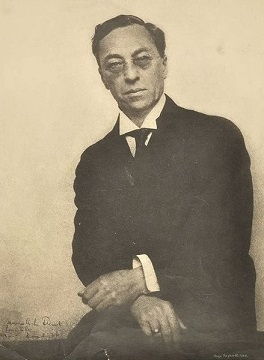
Kandinsky's work, both artistic and theoretical, played a large role in the philosophic foundation for later modern movements, in particular Abstract Expressionism and its variants like Color Field Painting. His late, biomorphic work had a large influence on Arshile Gorky's development of a non-objective style, which in turn helped to shape the New York School's aesthetic. Jackson Pollock was interested in Kandinsky's late paintings and was fascinated by his theories about the expressive possibilities of art, in particular, his emphasis on spontaneous activity and the subconscious. Kandinsky's analysis of the sensorial properties of color was immensely influential on the Color Field painters, like Mark Rothko, who emphasized the interrelationships of hues for their emotive potential. Even the 1980s artists working in the Neo-Expressionist resurgence in painting, like Julian Schnabel and Philip Guston, applied his ideas regarding the artist's inner expression on the canvas to their postmodern work. Kandinsky set the stage for much of the expressive modern art produced in the 20th century.
Influences and Connections

-
![Paul Klee]() Paul Klee
Paul Klee -
![Franz Marc]() Franz Marc
Franz Marc -
![Walter Gropius]() Walter Gropius
Walter Gropius ![Arnold Schoenberg]() Arnold Schoenberg
Arnold Schoenberg
-
![William Baziotes]() William Baziotes
William Baziotes -
![Arshile Gorky]() Arshile Gorky
Arshile Gorky -
![Hans Hofmann]() Hans Hofmann
Hans Hofmann ![Hans Hartung]() Hans Hartung
Hans Hartung
-
![Solomon R. Guggenheim]() Solomon R. Guggenheim
Solomon R. Guggenheim ![Alexej von Jawlensky]() Alexej von Jawlensky
Alexej von Jawlensky
Useful Resources on Wassily Kandinsky
-
![Kandinsky in 6 Minutes: A Brief Look at His Life & How Impressionism & the Bauhaus Art Movement Influenced His Art]() 198k viewsKandinsky in 6 Minutes: A Brief Look at His Life & How Impressionism & the Bauhaus Art Movement Influenced His ArtOur PickAlso, see how his works became more abstract during his lifetime
198k viewsKandinsky in 6 Minutes: A Brief Look at His Life & How Impressionism & the Bauhaus Art Movement Influenced His ArtOur PickAlso, see how his works became more abstract during his lifetime -
![The Blue Rider Group in 5 Minutes: How Wassily Kandinsky and Franz Marc Paved the Way for Modern Art]() 18k viewsThe Blue Rider Group in 5 Minutes: How Wassily Kandinsky and Franz Marc Paved the Way for Modern ArtOur Pick
18k viewsThe Blue Rider Group in 5 Minutes: How Wassily Kandinsky and Franz Marc Paved the Way for Modern ArtOur Pick -
![Kandinsky and the Russian House]() 0 viewsKandinsky and the Russian HouseOur PickDocumentary on Kandinsky and the Russian avant-garde. Part II of this video is also available on YouTube
0 viewsKandinsky and the Russian HouseOur PickDocumentary on Kandinsky and the Russian avant-garde. Part II of this video is also available on YouTube
 Ask The Art Story AI
Ask The Art Story AI























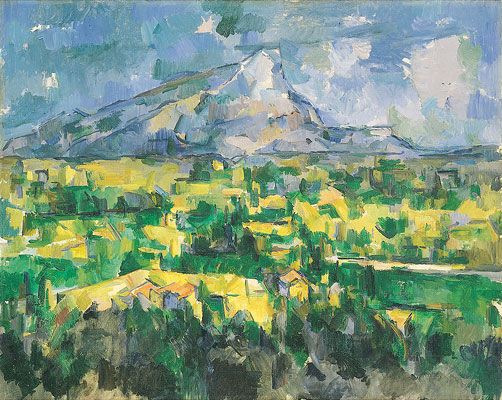
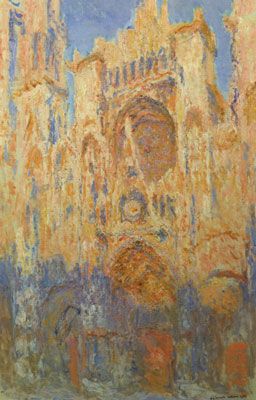
![Paul Klee: Highway and Byways [<i>Hauptweg und Nebenwege</i>] (1928)](/images20/works/klee_paul_5.jpg?3)




